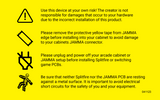The NAC Splitfire makes streaming and capturing JAMMA games easy. It provides amplified RGB output and safely attenuates speaker audio without disrupting your JAMMA setup.
Features:
- Buffered RGB with adjustable gain through a VGA port
- Isolated audio output with adjustable attenuation through a 3.5mm TRS jack
- High-quality Hirose JAMMA socket with G-pin (key)
- Hard gold plated JAMMA edge
Package Includes:
- One Splitfire PCB
- Printed instruction card
Designed by Michael Moffitt
Frequently Asked Questions
How does the Splitfire work exactly?
Your arcade cabinet’s controls, speaker connection, and RGB signals are connected directly to the game PCB. The Splitfire taps off the video signals with a high input impedance amplifier so as to not affect the signal level. As many games have varying RGB voltage levels, a Video Gain adjustment is provided. The RGB signal is presented via an HDB15 port (VGA) that may be easily connected to many common analog capture solutions.
The audio output is tapped from the balanced speaker signals produced by the JAMMA board, and run through a transformer in order to isolate the audio. An attenuation knob is provided to allow the reduction of the audio level. With the transformer, the JAMMA amplifier is not harmed by the audio output’s ground being common to the PCB’s DC ground connection.
Does the Splitfire add lag?
No! All signals are passed through directly to the cabinet. The video buffer is no more than an amplifier; there is no temporal buffering. Playing off of the secondary output is fine if you prefer it.
I have no image!
Check all of your connections, and ensure that the video gain knob has been turned clockwise. Check that your monitor and capture equipment are both receiving a sync signal, and that the game looks okay on your arcade cabinet.
Why is there a transformer?
JAMMA audio is balanced output, intended to drive a speaker directly. If the JAMMA connection is connected to the ground, it can damage some amplifier designs. To mitigate this risk, a transformer isolates the audio signal so that it may be used with reference to the same ground signal as the rest of the JAMMA PCB.
Can I use a Splitfire with non-JAMMA games?
Electrically, Splitfire will work with anything that produces RGB signals with a TTL-level composite sync, but it is designed for JAMMA hardware. If you make a custom adapter for your other hardware to plug in like a JAMMA board, it may be used.
Is it safe to use a Splitfire with a monitor that has 75-ohm termination (e.g. Sony PVM)?
Yes - Splitfire buffers RGB and sync signals thoroughly. The amplifier is designed to drive a 75-ohm load for the RGB signals, and a 470-ohm resistor in series with the sync output protects Splitfire’s sync buffer to provide the correct level for 75-ohm termination, producing the 0.7V signal that a PVM and other studio monitors will expect.
How are RGB signals buffered on the Splitfire?
A THS7316 high-bandwidth buffer is used to tap the original RGB signals and provide a buffered output. The Video Gain knob is a multi-gang potentiometer that allows a reduction of the signal before it reaches the amplifier.
How is sync buffered on the Splitfire?
A 74HCT-series logic IC is used to buffer the original sync signal, which is passed into two other buffers so that the arcade monitor sync and capture monitor sync signals are completely isolated and may be terminated separately. Even if you were to short out the external capture sync to ground, the arcade monitor would continue to work just fine (please, don’t do this, though).
Additional Disclaimers:
- Use this device at your own risk! The creator is not responsible for damages that occur to your hardware due to the incorrect installation of this product.
- Please unplug and power off your arcade cabinet or JAMMA setup before installing Splitfire or switching game PCBs.
- Be sure that neither Splitfire nor the JAMMA PCB are resting against a metal surface. It is important to avoid electrical short circuits for the safety of you and your equipment.






